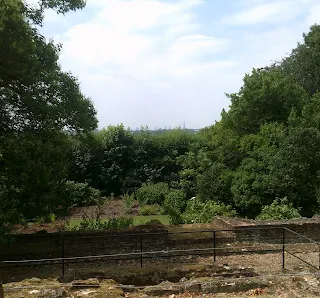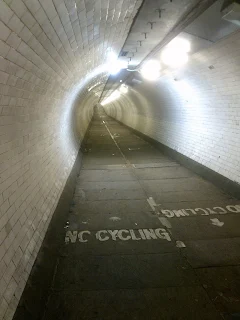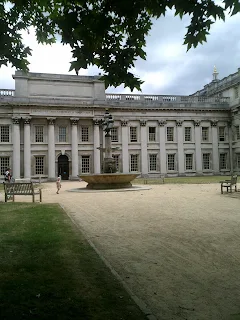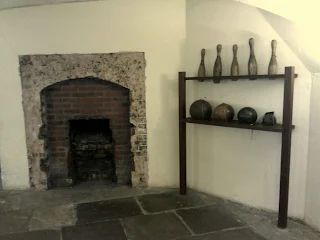So, there was me recommending the Old Royal Naval College to my tourist cousins... when I hadn't even been there myself! The audacity of it! That was soon remedied by a journey into Greenwich, which is not too difficult to reach from my east London home.
The current buildings sit on the site of what was once Greenwich Palace; the favourite dwelling of both Henry VIII (r.1509-1547) and his daughter, Elizabeth I (r.1558-1603).
Originally Bella Court, a manor house situated here in the 1420s, it was Henry VII who commissioned a new royal palace to be built here in the 1490s.
In 1649, royal possessions were removed from the site by order of Oliver Cromwell and demolition of the palace began in 1662.
The Royal Hospital was designed by Christopher Wren, its purpose being to accommodate veterans of the Royal Navy who had grown old or disabled in the service of their country. Funding for the project was erratic and the building, on the former palace site, took place in four main phases between 1696 and 1751. The first Greenwich pensioners arrived in 1705. The popularity of 'out-pensions' that enabled the pensioners to live independently contributed to a decline in hospital numbers, and the last pensioners left the hospital in 1869.
The Royal Naval College took over the site and opened here in 1873 with the purpose of training officers of every rank above midshipman. Many thousands of men and women undertook training here until 1998,when the training of Royal Navy, Royal Air Force and Army officers was merged in a purpose-built building at Shrivenham. The college then became known by its present moniker.
I always get off the Docklands train one stop early, so that I can walk through the Greenwich Foot Tunnel.
Here is the striking view of the ORNC from the north side of the water...
I walked down the stairs but looked back at the north lift...
The tunnel was opened in 1902 and was nice and peaceful when I started my walk- but that silence was soon shattered by a group of students with loud voices coming down the stairs after me. This tunnel doesn't half create an echo effect!
It's always lovely and cool down here, even on clammy days like the one when I visited Greenwich.
The no cycling rule doesn't always get adhered to...
Clearly climbing...
South lift...
The ORNC visitor centre is interesting and I didn't linger, but made a note to pop into the Old Brewery pub and restaurant on my next visit. Originally created to supply the sailors at the Royal Hospital their daily allowance of 'small' (weak) beer, there has been a brewhouse on the site since 1717.
My first view from the side of the ORNC...
The fountain. I always love a water feature!
Most of the buildings are given over to the University of Greenwich, although you can visit the central courts: named after King William, Queen Mary and Queen Anne. I also stuck my nose into a couple of classrooms.
The Trinity Laban Conservatoire of Music and Dance occupies the only other building (you could hear the music floating through the windows) and here is a photo of the King Charles Court at the centre...
I took some outdoor photos as the views are worth a Kodak moment or two. Here is the Water Gate. Visitors in the 19th century were encouraged to arrive by river so that they could enjoy the magnificence of the buildings from this classical viewpoint. I'm looking the other way!
London Docklands view...
The O2 (formerly the wacky, mad Millennium Dome, which I visited in 2000) and, if you peer, you can see the cable cars to the right of the photo. I've went on these about a year ago.
I stepped waaaaay back and took this building and Docklands shot...
The Queens House- built for Anne of Denmark, wife of James I- is the only part of Greenwich Palace which survives above ground today.
It's worth a visit, if only for its wonderful Tulip Stairs...
The Chapel from the outside...
Photography wasn't allowed in the Chapel of St. Peter and St. Paul, even without a flash. Words cannot express how much I HATE venues who get too precious about such things. Grrrr!
Here is a PDF of the inside.
Outside view of the Painted Hall...
The Painted Hall ceiling is in its final stages of refurbishment. Here's a PDF of what I would have seen from the floor if that hadn't been so...
Here's all I could see from the floor at the entrance point...
There is a room called the Nelson Room which is, apparently (according to Google), 'Off the Painted Hall...'
It was formerly the Hospital's Records Room and it's where Nelson's body was prepared after it was brought back from the Battle of Trafalgar but before he lay in state in the Painted Hall. Could I find the entrance to this room? Could I hell! On walking into the King William Court, staff told me that the one door I'd just left was the only accessible door, and maybe it's not possible to visit this room at the moment, due to the ongoing refurbishment works.
Here's a PDF of a statue of the man himself, which presides over the small exhibition in this room...
By now, this place was starting to underwhelm- with buildings now given over to education, a boarded up ceiling, the restriction of photography in the chapel and a skittle alley only accessible via a guided tour (I prefer to do things at my own pace)- I was about to call it a day.
But then I booked myself onto a Painted Ceiling tour, where you get to walk up 67 steps and stand two metres underneath the ceiling, instead of the sixty feet away you would be from the ground. At a tenner per person, the tour lasted well over an hour and I thought it was good value for money. Our tour guide was very informative and enthusiastic and you got to see the restorers/ artists at work.
Before you ascend, you get to see the upper hall ceiling. This part must have been completed, as it looked very fresh to me.
On the ceiling is Queen Anne and her husband. She's viewed as 'the past' as she died with no surviving heirs...
On the end wall are Georges I and II with the latter's son, Prince Frederick. With three generations of heirs, they are viewed as 'the future' of the monarchy; as indeed they were.
The two side paintings are, like the end wall painting, in the tromp l'oeil style, meaning 'to deceive the eye'. These paintings create an illusion of an object or scene as there are no parts of the painting (such as the frame) that are in relief.
I took this collective view after descending...
The Painted Hall was painted by relatively unknown artist James Thornhill, onto a prepared plaster base of lime, sand plaster and animal hair. The work was carried out in two stages between 1708 and 1727. The lower hall ceiling is an allegory- a picture that can be interpreted to reveal a hidden meaning, typically a moral or political one.
It is named The Triumph of Peace and Liberty Over Tyranny.
Here are some of my favourite parts.
This is Astronomer Royal John Flamsteed predicting an eclipse. There is the signature of a restorer written onto this part! Today's restorers have found over thirty signatures on the work- and no doubt added their own notifications!
This picture is flipped sideways, so that you can see the painting better.
Close-up of the details...
Goddess Diana is depicted, along with all the zodiac signs...
King William III and Queen Mary II. Mary had a restorer's graffiti across her breast!
John Worley was an unruly pensioner who was punished for drunkenness and disruptive behaviour, including inviting women back to his quarters. He lived to the age of 96, so maybe this lifestyle should be recommended to all!
This partially underground tunnel runs between the Chapel and the Painted Hall and was originally a makeshift mortuary. It was converted into the Skittle Alley in 1864 and was intended to help relieve the boredom of the pensioners.
It is only accessible via a guided tour. But, it's right near the toilets... and the door wasn't locked... so nosey parkers like myself just HAVE to enter and take photographs, don't they?!
Stored skittles...
It was the Painted Hall ceiling tour and the chance to have a sneaky, illegal look at the Skittle Alley that turned a day that threatened to be a damp squib around.
Once the restored ceiling is unveiled, I shall return for a good butcher's
xxxxxxxxxxxxxxxxxxxxxxxxxxxxxx





































































